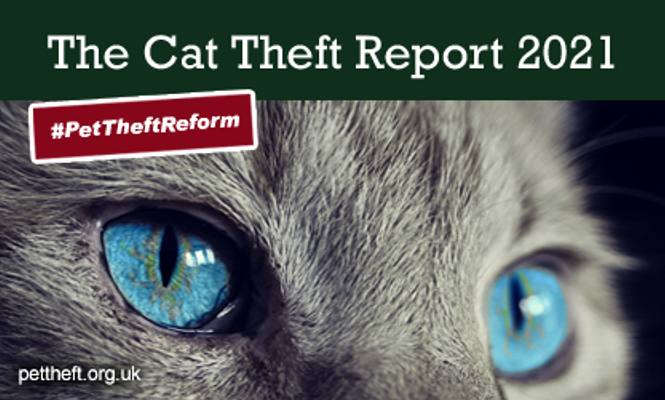CommentsANIMAL WATCH - In Dog Theft: Popular Campaign Relaunched, it was reported on October 6, 2021, that the UK government announced earlier this year that stealing dogs and other pets will be made a new criminal offense.
The proposal to make pet theft (called “abduction”) a criminal offense in England is one of a string of recommendations in a report by the Pet Theft Taskforce - set up to tackle an increase in incidents during the COVID lockdown.
The Taskforce – comprised of government officials, police, prosecutors, and local authorities – received evidence from animal welfare groups, campaigners, academics and other experts and “(i)t found that around 2,000 dogs were reported stolen last year, and that seven out of 10 pet thefts recorded by police involved dogs,” according to BBC.
“The law currently treats the theft of a pet the same as any loss of property, so a stolen dog would be viewed the same as a stolen laptop,” Dr. David Allen, head of the Pet Theft Reform campaign, points out. “An abducted family member is an inanimate object. This has had obvious implications on policing and sentencing, basically making pet theft a low-risk, high-reward crime.”

However, this is soon set to change under new legislation, after the pandemic saw a huge rise in pets being snatched.
Dog theft has soared in the UK since 2020, the article states, with demand for dogs surging during Covid lockdowns. Crimestoppers reports that last year, “up to seven pets were reported stolen every single day.”
This demand has driven up prices of dogs to record levels, with hikes up to 89% for the most desirable, Dogs Trust (the largest British animal-welfare organization) found, enhancing them as a target for criminals.
Considering these factors and the increasing pressure from campaigners, the Government set up a Pet Theft Taskforce in May 2021, the article states, and has pledged to create “a new criminal offense for pet abduction which will recognize “the emotional distress to the animal in addition to its owner.”
The current sentence for stealing a pet in the UK is “a maximum term of seven years, but the article states it is doubtful that this sentencing scale is used because just in the theft of a car or TV “the severity of the sentence is partly determined by the monetary value of the item taken.”
THE DETERRENT TO ENACTING AND ENFORCING THIS LAW IN THE U.S.
It must be noted that Los Angeles, much of California, and some other cities/areas in the U.S. have become part of an experimental program called “Human Animal Support Services,” which professes that “pets are more likely to find their owners if they stay in their neighborhoods.” And, cats (possibly owned and stray cats) are increasingly being released (at the instruction of animal shelters) back into the streets immediately as part of the TNR /(Trap/Neuter/Release/Return) and RTF (Return to Field) programs espoused by Best Friends Animal Society.
In 2017, then-Los Angeles Animal Services General Manager Brenda Barnette introduced a change to the City’s animal laws, “‘Finders, Keepers’: LA Doesn’t Want Your Lost Dogs or Cats in City Shelters, LA Animal Services GM Barnette Less Than Truthful about the New ‘Finders-Keepets” Law?, which was finally approved by the Animal Services Commission in 2019 and implemented by the City under Mayor Eric Garcetti.
This program makes it almost impossible to pursue lost and stolen pet complaints regarding any animal that is not microchipped, because it encourages strangers who find lost pets to keep them—purportedly after reporting a description of the pet to the Department (but there is no enforcement of this aspect).
After (an unverifiable) 30 days, the “finder” can legally go to the shelter and transfer ownership to themselves without the pet ever being impounded under State legal requirements for the owner to locate their pet. This is being administered by now-Assistant General Manager Annette Ramirez as the Department’s policy and appointments are required to bring in any found pets. This type of “managed-intake” program is also used in many areas and should be carefully examined for personal property law compliance in each state.
WHAT IS “EMOTIONAL DISTRESS?”
The Merriam-Webster definition is, “A highly unpleasant emotional reaction (as anguish, humiliation, or fury) which results from another’s conduct and for which damages may be sought—called also emotional harm, mental anguish, mental distress, mental disturbance, mental suffering.”
Any responsible owner who has experienced the theft of a pet would agree this is a conservative description of the disruptive and heart-wrenching pain which haunts them for the rest of their lives—not knowing what happened to their beloved and helpless furry family member.
EMOTIONAL DISTRESS LAW AND RECOVERY
Emotional distress is “a claim of damages in lawsuits for injury due to the negligence or intentional acts of another,” according to USLegal, Inc, which explains: “Damages for emotional distress used to require proof of a physical injury in order to be recoverable; however, recent case law has recognized a right to an award of money damages for emotional distress without physical injury or contact.”
USLegal, Inc., continues, “For instance, sexual harassment and libel and slander cases may involve emotional distress as the main, or only, harmful result….”
It cautions, “Professional testimony by a therapist or psychiatrist may be required to validate the existence and depth of the distress and place a dollar value on it.”
And, “To prove ‘intentional emotional distress,’ the plaintiff must show: 1) the defendant must act intentionally or recklessly; (2) The defendant’s conduct must be extreme and outrageous; and (3) the conduct must be the cause of severe emotional distress.”
INTENTIONAL INFLICTION OF EMOTIONAL DISTRESS LAW AND LEGAL DEFINITION
Intentional infliction of emotional distress or mental distress is a tort claim for intentional conduct that results in mental reaction such as anguish, grief, or fright to another person’s actions that entails recoverable damages. Some jurisdictions refer to IIED as the tort of outrage. (See the elements of a prima facie case for the tort of intentional infliction of emotional distress.)
Considering the extent to which some thieves go to steal a pet, doesn’t pet theft clearly fit these criteria?
PET THEFTS ARE OFTEN NOT CRIMES OF OPPORTUNITY
Just last week, a woman in Los Angeles who bought two purebred German Shepherd pups that are now close to six months old told me that her neighbor warned her of recent pet thefts in the community and that there was a new “cut” in the rear chain-link fence on her corner property, where a young male had been seen talking to her dogs while she was at work. When she examined the “cut” she realized that it was the crude beginning of an opening that could be enlarged easily to remove her dogs.
During a media campaign conducted in southern L.A. County a few years ago regarding the theft of small purebred dogs (particularly Yorkshire Terriers), six thefts had been reported in a particular area and all had occurred when the owner left home briefly, and one while the owner was standing in her unfenced front yard, sorting just-delivered mail while her toy Poodle explored the yard during this daily trip to the mailbox.
She vaguely noticed a white van pulled up and what appeared to be a utility workman exited the vehicle, scooped up her dog and ran back to the vehicle, which quickly sped away. In reviewing an entire string of similar dognappings, all the thefts had one thing in common—the white van.
Since these multiple thefts were being covered by a local TV station, we made the announcement that anyone with a small purebred dog in the area should be alert to this tip. Another common factor was that each of the stolen dogs had recently been taken to a local vet or grooming salon and driven directly home, which could have allowed the thieves to then follow without being noticed.
Within a week, an elderly woman who regularly took her two Yorkies to a nearby park to run off-leash, noticed a white van with two men in white uniforms soon parked near her car and one was looking in her front window, where she had placed incominig mail on her dashboard, showing her address. She immediately called 911 and two police officers arrived, questioned the men and found they had warrants for their arrest. Investigation disclosed that they were running a dog-theft operation that targeted small, desirable expensive dogs.
All these men had to do was watch someone with a targeted dog and either follow them home or write down their address from mail left in their vehicle and they could monitor daily routines which included leaving the dog at home in a yard or taking it to an outside location where the pet could be snatched when the owner was distracted.
Some breeds are so in demand that it is well worth the risk to steal them.
LADY GAGA’S FRENCH BULLDOGS
One of the latest and most publicized dog thefts occurred when Lady Gaga’s dog walker was shot and her three dogs kidnapped (one escaped and ran back to the side of the caretaker.) Offering a $500,000 reward resulted in the dogs mysteriously reappearing but most dog thefts do not get that kind of spotlight and publicity. However, it is also probably not likely that this was a spontaneous theft—probably the dog walker followed a similar pattern regularly, allowing the thieves to observe and plan their action.

Can we even imagine the anguish of having a pet scooped up in your presence, grabbed from your yard or taken from a vehicle where it is left alone?
Dog thefts occasionally occur during the commission of another crime, such as home burglary, but in many instances they can be avoided with the awareness that someone may always be watching and planning a dognapping—especially of expensive breeds of small dogs.
As one author cited, it is generally much easier to steal a small dog than a wolfhound. But this doesn’t mean large dogs are never victims and need thoughtful and airtight security.
Dog Theft: A Case for Tougher Sentencing Legislation
This is a very important must-read NCBI study by Lauren K. Harris in 2018, in which she described many long-held tenets that are changing, based upon “evidence that human-human relationships are becoming less secure and more transient in modern society, and some authors have linked reduced security in human relationships to the increase in companion animal guardianship and increased reliance on the companionship of non-human animals [11].”
“Companion animal guardians often report that they consider their companions to be members of the family. For example, one survey found that 87%, and another found that 99%, of respondents considered their companion animals to be family members 12]).
And, “Another survey found that 95% of companion animal guardians regarded their animals as “friends” [12]).”
She also cites that, “The dog-human bond has been likened to that found between a parent and child; one study used functional magnetic resonance imaging (FMRI) to scan mothers’ brains while they viewed a series of photographs of either their child or of their dog. This study found that the brain regions activated when mothers viewed images of their children were similar to those activated when they viewed pictures of their dog. These brain regions were those associated with “emotion, reward, affiliation, visual processing and social cognition” [13].”
THE VALUE OF A “USED” DOG / “Where the dog has no market value”
It is easy to understand the monetary benefits of stealing a young purebred puppy or an unaltered adult dog that can be used for breeding, but “Dog Bite King” attorney Kenneth M. Phillips reminds us that in cases of a dog being killed or dying as the result of an attack (or in this discussion, is stolen):
“Where a dog has no market value, or market value is not a true indication of value, the proper measure for the killing of the dog is the dog's value to its owner.”
And in, Georgia’s Supreme Court Offers Value to Dog’s Life
“The Supreme Court agreed with that portion of the Appeal Court’s decision, noting that sentimental worth of a pet is not recoverable; however, the Court pointed out that “both qualitative and quantitative” evidence could be used to determine the pet’s fair market value.”
What is the Legal Value of a Cat?
“ Under California law, the general measure of damages for injury to personal property is based upon the actual diminution in value which results from the injury to the personal property,” states the law firm of Reid & Hellyer.
But, the firm cites, “In the recent case of Kimes v. Grosser (2011) 195 Cal.App.4th 1556, a cat owner sued his neighbors for costs incurred after the neighbors allegedly shot and injured the cat.
The cat, which was described as an adopted stray of very low economic value, required extensive medical treatment resulting in costs of approximately $36,000.00. The plaintiff sought to recover these costs from the neighbors, though the neighbors argued that their liability was limited to the amount by which the shooting reduced the cat’s fair market value.
“The trial court granted the defendants’ motion at the outset of trial, limiting the measure of damages of the pet owner to the diminution in value of the cat, as opposed to the out of pocket medical expenses incurred in saving the cat.
The plaintiff pet owner declined to proceed with the action, effectively conceding that the cat had no economic value that justified the expenses of the trial. As a result, the trial court entered a judgment of dismissal and the plaintiff appealed.
The Court of Appeal in Kimes reversed the judgment of dismissal, determining that the pet owner could recover the costs of care of the pet if the costs were found to be reasonable and necessary….The court in Kimes concluded that the plaintiff was not seeking to recover an unsupportable amount of damages, but was instead seeking to present evidence of the costs incurred for the cat’s care and treatment by virtue of the shooting.
As held by the court in Kimes, this was a “rational way” of demonstrating a measure of damages apart from the cat’s market value. . .The court in Kimes finally concluded that because pets are considered to be property of the owner, Civil Code section 3340 authorized the plaintiff to seek a recovery of punitive damages.
Reid & Hellyer, APC also just announced that Marie Elena Wood, a former attorney of the firm was appointed on September 3, 2021 by Governor Gavin Newsom to serve as a California Superior Court Judge (See media release here.)
SHOULD EMOTIONAL DISTRESS BE INCLUDED IN LAWS?
So, there seems to be no doubt that the theft of a pet can cause unbearable pain. But, is it time for emotional distress to be included in dog, cat or other pet animal theft laws?
(Phyllis M. Daugherty is a contributor to CityWatch and a former Los Angeles City employee.)






